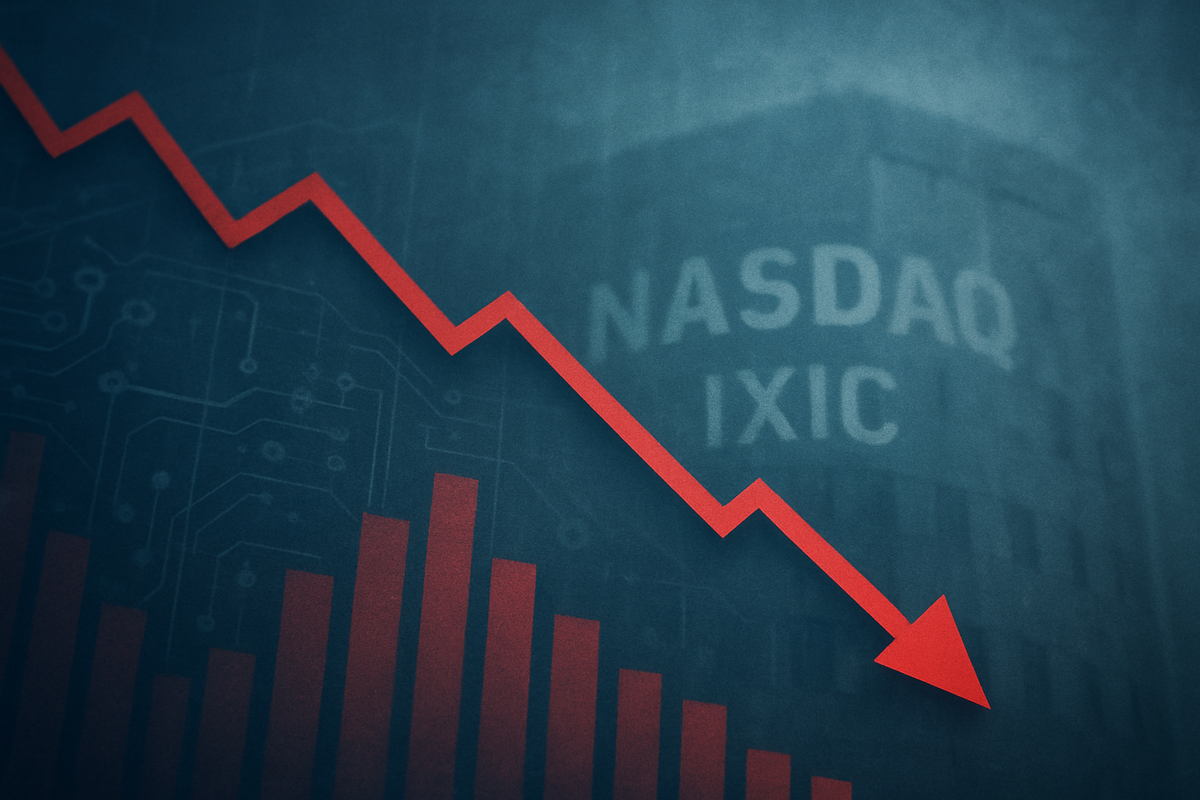
November 13, 2025 – The technology sector of the S&P 500 (SPX) experienced a significant negative performance today, contributing to an extended slide in the Nasdaq Composite (IXIC) and sending ripples of caution across the broader market. This downturn, driven by a confluence of factors including concerns over inflated valuations, persistent macroeconomic headwinds, and a re-evaluation of the artificial intelligence (AI) boom, has triggered a broad market decline, with the Nasdaq Composite reportedly dropping between 1.8% and 2.4%, and the S&P 500 (SPX) seeing declines of 0.6% to 1.7%. The Dow Jones Industrial Average (DJIA) also felt the pressure, shedding hundreds of points.
This market movement signals a potential inflection point, prompting investors to reassess risk and re-evaluate growth strategies. The immediate implications include a heightened sense of investor caution, a pronounced shift towards risk aversion, and a likely rotation of capital out of high-flying technology and growth stocks into more defensive or value-oriented sectors. The "Magnificent Seven" – a group of mega-cap tech companies including Nvidia (NVDA), Apple (AAPL), Microsoft (MSFT), Amazon (AMZN), Alphabet (GOOGL), Tesla (TSLA), and Broadcom (AVGO) – are reportedly leading the declines, underscoring the interconnectedness of these giants with overall market performance.
Detailed Coverage: Unpacking the Tech Sector's Turbulence
Today's downturn in the technology sector is not an isolated event but rather the culmination of growing unease regarding market valuations and the sustainability of recent tech-driven rallies. The extended slide of the Nasdaq Composite (IXIC) on November 13, 2025, reflects a market grappling with the sustainable profitability of significant investments, particularly in the AI space, moving beyond speculative potential to demand clearer pathways to revenue and earnings.
Historically, such downturns are often rooted in speculative bubbles and overvaluation, where investor optimism inflates asset prices far beyond their intrinsic value. Periods of loose monetary policy and cheap capital, which encourage speculative investments, are often followed by rising interest rates, making borrowing more expensive and significantly impacting growth-oriented tech companies whose valuations rely on discounted future earnings. Economic uncertainty, recession fears, and a lack of profitability in some tech ventures further exacerbate these conditions.
Leading up to this moment, the market has seen a sustained period of rapid growth in the technology sector, driven by innovation and increasing adoption of new technologies. However, this has been followed by an inflation of valuations, often decoupled from underlying financial performance, characterized by intense speculation and widespread media hype. Today's decline serves as a trigger event, marking an initial sharp drop and signaling the beginning of a potential sustained period of re-evaluation. Key players like the "Magnificent Seven" (Nvidia (NVDA), Apple (AAPL), Microsoft (MSFT), Amazon (AMZN), Alphabet (GOOGL), Tesla (TSLA), Broadcom (AVGO)) are at the forefront of these movements, given their substantial market capitalization within the Nasdaq Composite (IXIC) and S&P 500 (SPX). Initial market reactions are characterized by panic selling, increased volatility, and an immediate questioning of existing valuations.
Companies on the Brink: Winners and Losers in a Tech Downturn
A significant negative performance in the technology sector invariably creates a clear divide between companies that thrive and those that struggle. The current environment, marked by the Nasdaq's extended slide, will likely expose vulnerabilities and highlight the resilience of others.
Companies most likely to lose are those with highly speculative business models, particularly those reliant on future growth projections rather than current profitability. Overvalued companies with unproven business models, high debt loads, and large employee footprints will face immense pressure. Firms whose products or services are considered non-essential and depend heavily on discretionary spending, such as certain e-commerce platforms or advertising technology segments, are also vulnerable. Historically, companies like Pets.com and Webvan from the dot-com era, which burned through capital without generating profits, serve as cautionary tales. More recently, companies that experienced explosive growth during boom periods, especially those with "stretched valuations" linked to speculative trends, face significant pullbacks. Even established giants like Microsoft (MSFT) and Amazon (AMZN) can experience significant short-term losses during broader market pullbacks from high valuations.
Conversely, companies poised to win or demonstrate resilience during this downturn often provide mission-critical and cost-saving solutions. Businesses offering essential services or technologies that help other companies reduce costs, improve efficiency, or maintain critical operations – such as cybersecurity and information backup solutions – tend to perform well. Subscription-based cloud software (SaaS) companies, especially those with "seat-based pricing" tied to enterprise users, have historically proven more resilient due to their recurring revenue models. Examples include human capital management and finance application providers like Workday (WDAY), Paycom (PAYC), and Intuit (INTU). Established tech giants with robust balance sheets, strong cash flow, and diversified revenue streams, such as Apple (AAPL) and Alphabet (GOOGL), are better positioned to weather the storm, potentially even leveraging their financial strength to acquire struggling smaller companies. Tech infrastructure providers, including data centers (Digital Realty Trust (DLR)) and telecommunication towers (SBA Communications (SBAC)), also tend to remain in demand.
Wider Significance: A Rebalancing Act for the Digital Economy
The tech sector's significant downturn on November 13, 2025, extends far beyond stock prices, signaling a crucial rebalancing act within the broader digital economy. This event reflects a market grappling with the sustainable profitability of massive investments, particularly in areas like Artificial Intelligence (AI), demanding clearer pathways to revenue and earnings over speculative potential. This shift often triggers a "sector rotation," where capital moves from high-flying tech to more stable equity sectors such as healthcare, basic materials, and financials. It also forces a re-evaluation of valuation multiples, especially for growth stocks, as investors prioritize demonstrable profitability and sustainable business models.
The ripple effects are substantial. Companies heavily reliant on venture capital funding or those with less diversified revenue streams will find it harder to secure financing, potentially leading to consolidation or failure. Even established giants, while more resilient, will face increased scrutiny and may capitalize on opportunities to acquire struggling startups at reduced valuations. The talent market will also be affected, with layoffs and hiring freezes becoming prevalent, leading to job insecurity for tech workers. The interconnectedness of the tech ecosystem means a slowdown in one area, such as semiconductor demand from AI companies, can quickly affect related industries.
Historically, this situation draws strong parallels to the Dot-Com Bubble of the late 1990s and early 2000s. That era saw immense excitement around the internet, rapidly rising valuations based on future potential, and high market concentration. The Nasdaq Composite (IXIC) soared 600% between 1995 and its peak in March 2000, only to fall 78% by October 2002. The aftermath included widespread job losses, bankruptcies, and increased regulatory scrutiny, leading to legislation like the Sarbanes-Oxley Act of 2002. While some experts argue that today's tech cycle, particularly with AI, is underpinned by more tangible earnings growth, vigilance against speculative excess remains crucial. Regulatory bodies may increase scrutiny on antitrust issues, market dominance, and data privacy, and policymakers might implement measures to stimulate innovation and investment.
What Comes Next: Navigating the Evolving Tech Landscape
Following a significant downturn in the technology sector, the market enters a period of profound re-evaluation and adaptation, presenting both short-term challenges and long-term opportunities.
In the short term, continued market volatility is expected, with investors maintaining a cautious approach. The focus will intensify on corporate fundamentals, demanding demonstrable profitability and sustainable business models. Sector rotation, with capital shifting towards traditional and value-oriented industries, will likely persist. Companies will continue to implement cost-cutting measures, including layoffs and hiring freezes, as they prioritize efficiency. Macroeconomic headwinds, such as elevated interest rates and global economic slowdowns, will remain influential factors, impacting borrowing costs and valuations.
Long-term possibilities, however, suggest a resilient outlook for the technology sector, particularly in foundational areas like Artificial Intelligence (AI). This downturn may serve as a "healthy consolidation," paving the way for a new era of market leadership and more sustainable growth. Historically, while severe downturns can take years for full recovery, companies with strong fundamentals tend to rebound more quickly. New leaders may emerge, and increased integration of technology across various industries is anticipated, driven by advancements in AI, enhanced security, 5G Industrial IoT, and autonomous systems.
Strategic pivots for companies will be paramount. Prioritizing profitability and efficiency over "growth at any cost" will become the norm. Cost-cutting, workforce adjustments, and strategic innovation focused on "hot markets" like AI and cybersecurity will be crucial. Enhanced risk management, diversification, and a focus on ethical AI development will also be key. Market opportunities will arise from undervalued assets and continued growth in essential technologies like AI and cloud computing. Mergers and acquisitions are expected to rebound, with a focus on larger, strategic deals. Challenges will include persistent valuation concerns, a contraction in venture capital funding, and the potential for "jobless growth" due to AI-driven automation. Potential scenarios range from a "soft landing" with gradual recovery to a "hard landing" with a prolonged downturn, or a "two-speed market" where established giants perform well while smaller growth stocks struggle.
Comprehensive Wrap-up: A Market in Transition
Today's significant negative performance in the technology sector and the extended slide of the Nasdaq Composite (IXIC) on November 13, 2025, underscore a critical juncture for the financial markets. This event highlights the inherent volatility of the tech industry, particularly when speculative fervor outpaces fundamental realities, echoing historical precedents like the dot-com bubble.
Key takeaways from such a downturn include the crucial role of overvaluation and speculative investment as primary drivers of market corrections. The macroeconomic environment, specifically rising interest rates and inflation, significantly influences capital flow and company valuations. The immediate impacts are substantial financial losses, job insecurity, and a widespread reevaluation of business models, with a renewed emphasis on profitability and sustainable growth.
Moving forward, the market is likely to remain in a state of transition. While the path to recovery can vary in duration, history suggests that markets ultimately rebound. This period serves as a necessary "reset," distinguishing sustainable growth from speculative hype and fostering a more resilient tech ecosystem. Innovation, particularly in areas like AI, is expected to continue driving long-term growth, albeit with a stronger focus on tangible returns. The lasting impact will be a shift in investor sentiment, prioritizing demonstrable earnings and robust business models over speculative potential.
For investors in the coming months, discipline and a long-term perspective are paramount. Maintaining a diversified portfolio across various asset classes and geographies is crucial for mitigating risk. Focusing on quality companies with strong financials, clear business models, and a proven path to profitability will be key. Dollar-cost averaging can help navigate volatility by averaging out purchase prices. Crucially, investors should stay informed on economic indicators such as interest rates, inflation trends, consumer sentiment, jobs reports, and corporate earnings, especially scrutinizing tech companies' reports for evidence of profitability and tangible returns on AI investments. Finally, avoiding emotional decisions and sticking to a well-defined investment plan is essential to navigate the evolving market landscape and capitalize on future opportunities as the tech sector adapts and innovates.
This content is intended for informational purposes only and is not financial advice






